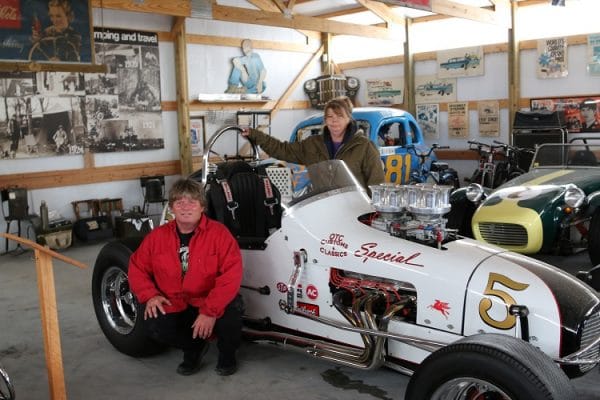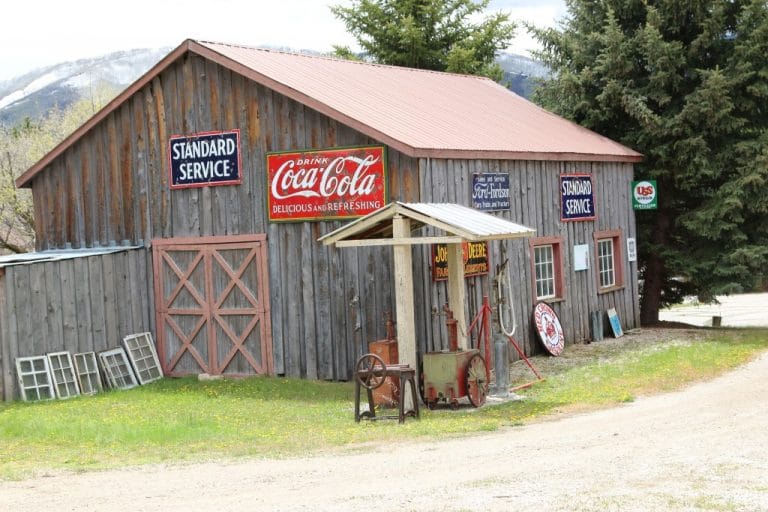
Passion for acquiring leads to eclectic collection
Wallsburg, Utah—On a tip from Utah antique picker Matt Binyon of American Rust Company, I visited what he described as “one of the most amazing ranches/museums I’ve ever seen.”, Richard Erickson’s 300-acre ranch in Wallsburg, Utah.
I don’t know Matt as someone who uses hyperbole or conjecture, but he has seen a lot of cool places, so I thought I should check the ranch out for myself. And besides, Wallsburg was a Utah town I had never seen. Erickson’s daughter, Pam, accommodated my request for a tour and a story.
Visiting Richard Erickson’s ranch gave me a sense of one man’s entire history along with his values, work, and passion. Erickson’s passion was mostly for antique steam engines, farm equipment, cabins, motorcycles, and tools and signs of all kinds.
His collection consists of well over a thousand rare and precious antiques and relics.
The wow factor of everything at this ranch leaves me humbled by how to put such an enormous amount of content into words, so I’ll begin where Mr. Erickson’s passion originated.
Erickson worked in one of the first Harley Davidson motorcycle dealerships in Utah when he was just 17. “Dad loved to work and he loved that job,” says his daughter Pam Williams. Besides his affinity for deriving power from big engines on two wheels, Erickson loved preserving the past.
Erickson started his own excavation and demolition business in Murray in the 1950s with a single Ford truck, and over the course of fifty years, made millions of dollars. He passed away last fall at the age of 83. He is remembered and adored by his children, Pam and Todd, who generously took me on tour of their amazing museum/ranch, the scope of which is overwhelming.
Erickson sought a clear answer to the question of what a person should do who has everything and has the time and money to pursue their passion. His solution was to search the United States for steam tractors and Harley Davidson and Indian motorcycles.
Although Erickson and his wife didn’t do a lot of farming, they still managed to build a collection of antique farm equipment that demonstrates the technological evolution of the piston driven engine, first by coal-powered steam, right up to the first internal-combustion engines.
The first steam engines were used to do more serious work like milling massive trees into lumber and powering the first factories. Erickson’s ranch has a fully operational steam-powered lumber mill.
I could have spent all day there just digging through all these artifacts, but we needed to move on from the tractors because there was still so much to see. It was a lot to take in in only two hours. The Discovery Channel could make a six-part series on this ranch and barely scratch the surface.
Pam and Todd are the trustees and superintendents of the Richard Erickson Foundation, which is responsible for maintaining this massive museum/ranch. There is a village along with a preserved mechanic shop and lots of old signs related to long-lost makes and models of tractors and product brands I’ve never heard of.
In the village is a cafe that existed on 1700 South and 300 West in Salt Lake City, completely preserved. There is a shoe repair shop and lots of cabins, and here, one can use their imagination to envision an original pioneer settlement.
I have always had a fascination for early print shops that churned out daily newspapers, so when we entered a building containing an entire former Salt Lake Times print shop, I was mesmerized. When Todd and Pam say, “Yeah, there is something here for just about everybody,” they certainly mean it.
Todd says that his mother, Rita, and father would travel the country in their quests. He and his sister traveled with their Dad, adding to his collection and buying dozens of tractors together.
They moved the Pioneer cabins to the property just as many of them were about to be razed for newer structures. He and his dad dismantled and rebuilt the cabins, including the cabin his great-grandfather built in 1877.
Inside a garage at the front of the property is a Cessna single-engine airplane. This enabled Erickson and Rita to travel to Salt Lake to conduct business within about 30 minutes. They were also able to travel to sites that might have tractors worth buying.
“It was certainly more than a hobby. This was his passion. This was his full-time job,” Todd says.
Todd and Pam agree that their dad was about as great of a dad as any kid could imagine growing up with. “He had a love of life. He was an excellent father and husband. He was an accomplished musician and an amazing businessman.”
At one point in the tour they point to his desk and say, “My dad made millions sitting at this desk.”
As far as examining how various millionaires spend their money by putting it in banks, stocks, or real estate, Richard Erickson’s millions were put into preserving things of antiquity—old tractors, cars, motorcycles, and pioneer structures—essentially preserving our pioneer and farming legacy in Utah. And this writer appreciates that.
The Richard Erickson Foundation is only open one weekend every year. Their annual event will be this coming June 21 through June 23, in Wallsburg, Utah. Visit RichardEricksonFoundation.org for more information.






